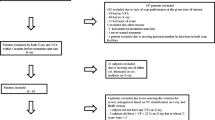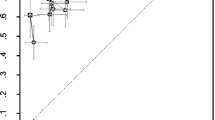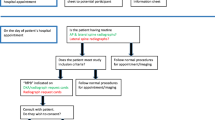Abstract
Summary
The utility of vertebral fracture assessment (VFA) by DXA to detect prevalent vertebral fracture in a multicenter setting was investigated by comparison to conventional radiography. While limited by lower image quality, overall performance of VFA was good but had a tendency to miss mild prevalent fractures.
Introduction
In osteoporosis clinical trials standardized spine radiographs are used to detect vertebral fractures as a study endpoint. Lateral spine imaging with dual X-ray absorptiometry (DXA) scanners, known as vertebral fracture assessment (VFA) by DXA, presents a potential alternative to conventional radiography with lower radiation dose and greater patient convenience.
Methods
We investigated in a multicenter setting the ability of VFA to detect fractures in comparison with conventional radiography. The study examined 203 postmenopausal women who had imaging of the spine by DXA and radiography. Three radiologists experienced in vertebral fracture assessment independently read the VFA scans and radiographs using the Genant semiquantitative method on two occasions.
Conclusions
Analyzing the data from all readable vertebrae, the kappa statistic, sensitivity, and specificity ranged from 0.64–0.77, 0.65–0.84, and 0.97–0.98, respectively. Considering only moderate and severe fractures improved the kappa statistic (0.80–0.91) and sensitivity (0.70–0.86). While image quality of VFA is inferior to radiography, the detection of vertebral fractures using visual scoring is feasible. However, VFA underperformed due to unreadable vertebrae and reduced sensitivity for mild fractures. Nevertheless, VFA correctly identified most moderate and severe vertebral fractures. Despite this limitation, VFA by DXA provides an important tool for clinical research.


Similar content being viewed by others
References
Rea JA, Chen MB, Li J et al (2000) Morphometric X-ray absorptiometry and morphometric radiography of the spine: a comparison of prevalent vertebral deformity identification. J Bone Miner Res 15:564–574
Steiger P, Cummings SR, Genant HK et al (1994) Morphometric X-ray absorptiometry of the spine: correlation in vivo with morphometric radiography. Study of Osteoporotic Fractures Research Group. Osteoporos Int 4:238–244
Chappard C, Kolta S, Fechtenbaum J et al (1998) Clinical evaluation of spine morphometric X-ray absorptiometry. Br J Rheumatol 37:496–501
Rea JA, Li J, Blake GM et al (2000) Visual assessment of vertebral deformity by X-ray absorptiometry: a highly predictive method to exclude vertebral deformity. Osteoporos Int 11:660–668
Ferrar L, Jiang G, Eastell R et al (2003) Visual identification of vertebral fractures in osteoporosis using morphometric X-ray absorptiometry. J Bone Miner Res 18:933–938
Ferrar L, Jiang G, Barrington NA et al (2000) Identification of vertebral deformities in women: comparison of radiological assessment and quantitative morphometry using morphometric radiography and morphometric X-ray absorptiometry. J Bone Miner Res 15:575–585
Pavlov L, Gamble GD, Reid IR (2005) Comparison of dual-energy X-ray absorptiometry and conventional radiography for the detection of vertebral fractures. J Clin Densitom 8:379–385
Rea JA, Chen MB, Li J et al (1999) Morphometric X-ray absorptiometry and morphometric radiography of the spine: a comparison of analysis precision in normal and osteoporotic subjects. Osteoporos Int 9:536–544
Crabtree N, Wright J, Walgrove A et al (2000) Vertebral morphometry: repeat scan precision using the Lunar Expert-XL and the Hologic 4500A. A study for the ‘WISDOM’ RCT of hormone replacement therapy. Osteoporos Int 11:537–543
Ferrar L, Jiang G, Eastell R (2001) Short-term precision for morphometric X-ray absorptiometry. Osteoporos Int 12:710–715
Vokes TJ, Dixon LB, Favus MJ (2003) Clinical utility of dual-energy vertebral assessment (DVA). Osteoporos Int 14:871–878
Binkley N, Krueger D, Gangnon R et al (2005) Lateral vertebral assessment: a valuable technique to detect clinically significant vertebral fractures. Osteoporos Int 16:1513–1518
Chapurlat RD, Duboeuf F, Marion-Audibert HO et al (2006) Effectiveness of instant vertebral assessment to detect prevalent vertebral fracture. Osteoporos Int 17:1189–1195
Damiano J, Kolta S, Porcher R et al (2006) Diagnosis of vertebral fractures by vertebral fracture assessment. J Clin Densitom 9:66–71
Schousboe JT, Debold CR (2006) Reliability and accuracy of vertebral fracture assessment with densitometry compared to radiography in clinical practice. Osteoporos Int 17:281–289
Genant HK, Wu CY, van Kuijk C et al (1993) Vertebral fracture assessment using a semiquantitative technique. J Bone Miner Res 8:1137–1148
Lang T, Takada M, Gee R et al (1997) A preliminary evaluation of the lunar expert-XL for bone densitometry and vertebral morphometry. J Bone Miner Res 12:136–143
Rea JA, Steiger P, Blake GM et al (1998) Optimizing data acquisition and analysis of morphometric X-ray absorptiometry. Osteoporos Int 8:177–183
Vallarta-Ast N, Krueger D, Binkley N (2006) Addition of right lateral decubitus positioning improves vertebral visualization with VFA in selected patients. J Clin Densitom 9:375–379
Delmas PD, Genant HK, Crans GG et al (2003) Severity of prevalent vertebral fractures and the risk of subsequent vertebral and nonvertebral fractures: results from the MORE trial. Bone 33:522–532
Acknowledgments
The authors wish to acknowledge Diane Krueger (University of Wisconsin–Madison) and the study nurses and technologists for assistance in data acquisition and preparation as well as the study participants who volunteered to participate in this research.
Funding
The collection and central review of radiographs and VFA scans was supported by Eli Lilly and Co.
Conflicts of interest
Doctors Fuerst, Wu, Genant, von Ingersleben, and Chen are employees and shareholders of Synarc, Inc. Dr. Mitlak is an employee and shareholder of Eli Lilly and Company. No other disclosures.
Author information
Authors and Affiliations
Corresponding author
Rights and permissions
About this article
Cite this article
Fuerst, T., Wu, C., Genant, H.K. et al. Evaluation of vertebral fracture assessment by dual X-ray absorptiometry in a multicenter setting. Osteoporos Int 20, 1199–1205 (2009). https://doi.org/10.1007/s00198-008-0806-9
Received:
Accepted:
Published:
Issue Date:
DOI: https://doi.org/10.1007/s00198-008-0806-9




